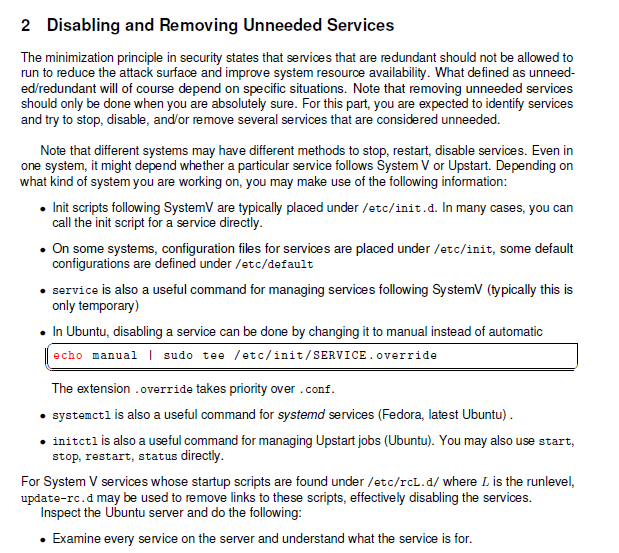Answered step by step
Verified Expert Solution
Question
1 Approved Answer
Share the screenshots of the linux terminal for the above questions 2 Disabling and Removing Unneeded Services The minimization principle in security states that services


Share the screenshots of the linux terminal for the above questions
2 Disabling and Removing Unneeded Services The minimization principle in security states that services that are redundant should not be allowed to run to reduce the attack surface and improve system resource availability. What defined as unneeded/ redundant will of course depend on specific situations. Note that removing unneeded services should only be done when you are absolutely sure. For this part, you are expected to identify services and try to stop, disable, and/or remove several services that are considered unneeded. Note that different systems may have different methods to stop, restart, disable services. Even in one system, it might depend whether a particular service follows System V or Upstart. Depending on what kind of system you are working on, you may make use of the following information: - Init scripts following SystemV are typically placed under /etc/init.d. In many cases, you can call the init script for a service directly. - On some systems, configuration files for services are placed under /etc/init, some default configurations are defined under /etc/default - service is also a useful command for managing services following SystemV (typically this is only temporary) - In Ubuntu, disabling a service can be done by changing it to manual instead of automatic echo manual I sudo tee /etc/init/SERVICE. override The extension . override takes priority over . conf. - systemctl is also a useful command for systemd services (Fedora, latest Ubuntu). - initct1 is also a useful command for managing Upstart jobs (Ubuntu). You may also use start, stop, restart, status directly. For System V services whose startup scripts are found under /etc/rcL. d/ where L is the runlevel, update-rc. d may be used to remove links to these scripts, effectively disabling the services. Inspect the Ubuntu server and do the following: - Examine every service on the server and understand what the service is for. - Explain the following services then disable and remove them: telnet, xinetd. - Explain the following services then disable them: cups, nfs, smbd, bind9. Note: Use a proper command such as apt-get purge or apt-get remove --purge to remove a package, do not delete the binaries manuallyStep by Step Solution
There are 3 Steps involved in it
Step: 1

Get Instant Access to Expert-Tailored Solutions
See step-by-step solutions with expert insights and AI powered tools for academic success
Step: 2

Step: 3

Ace Your Homework with AI
Get the answers you need in no time with our AI-driven, step-by-step assistance
Get Started


